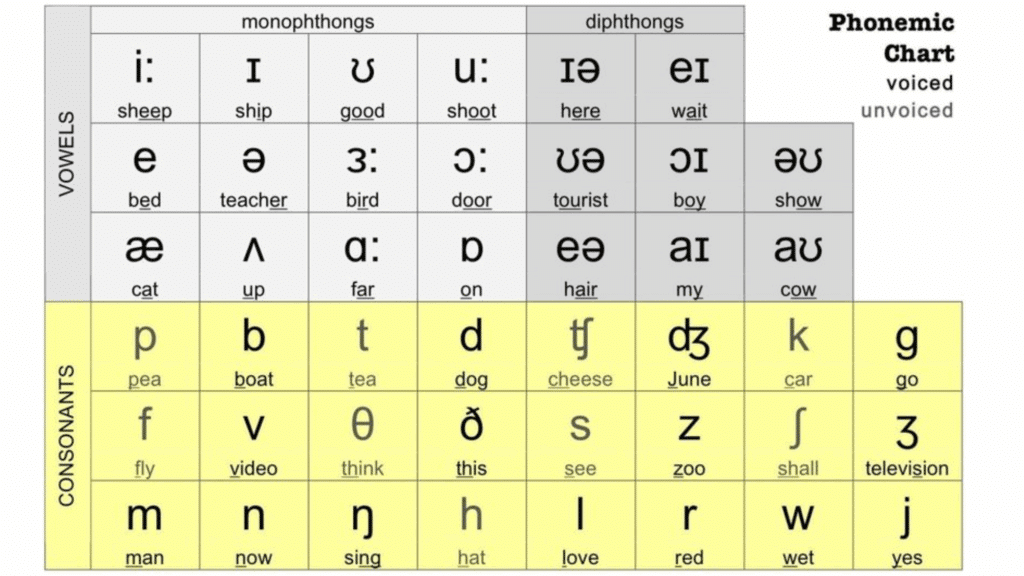Reading and speaking English often feels like a puzzle with missing pieces. Students struggle with new words, get stuck on spelling, and feel lost when trying to sound out unfamiliar terms.
Their confidence drops with each mispronounced word. The phonemes are the building blocks of English sounds that make reading and speaking much easier.
With these tools, anyone can break down tricky words into simple parts and say them correctly the first time.
This post will show you what phonemes are, why they matter, and how to use them to make English less confusing and more fun. Ready to see how these small sounds can make a big difference?
What are the Phonemes?

Phonemes are the smallest units of sound in a language that help tell words apart. Think of them as the building blocks of spoken words.
For example, the word “cat” has three phonemes: /k/, /a/, and /t/. Change the first sound to /h/, and you get “hat” a whole new word because of just one different phoneme.
Phonemes don’t always match up with single letters. Sometimes, two letters together make one sound, like “ch” in “chair.”
Learning about phonemes helps with reading and spelling because it teaches how words are made from sounds, not just letters. This skill is called phonemic awareness, and it’s key for strong reading skills.
How Many Phonemes Are There in The English Language?
English has about 44 phonemes, which are the smallest units of sound that make up words.
These 44 phonemes include different types of sounds: 19 consonant sounds, 7 digraphs (like “ch” or “sh”), 5 r-controlled vowel sounds (like “ar” in “car”), 5 long vowels, 5 short vowels, 2 “oo” sounds, and 2 diphthongs (sounds made by blending two vowels together, like “oi” in “coin”).
Even though there are only 26 letters in the alphabet, these letters combine in different ways to create all the sounds needed for English words.
Learning about these 44 phonemes helps readers and writers break words into sounds, making it easier to read, spell, and pronounce new words confidently.
A Brief List of Phonemes
Here’s a quick look at 44 phonemes in the English language. This brief list shows different sounds that make up words, helping with reading and spelling.
| No. | Phoneme | Example Word | Sound in Word |
|---|---|---|---|
| 1 | /p/ | pat | p |
| 2 | /b/ | bat | b |
| 3 | /t/ | top | t |
| 4 | /d/ | dog | d |
| 5 | /k/ | cat | c |
| 6 | /g/ | go | g |
| 7 | /f/ | fish | f |
| 8 | /v/ | van | v |
| 9 | /θ/ | think | th |
| 10 | /ð/ | this | th |
| 11 | /s/ | sun | s |
| 12 | /z/ | zebra | z |
| 13 | /ʃ/ | she | sh |
| 14 | /ʒ/ | measure | s |
| 15 | /h/ | hat | h |
| 16 | /m/ | man | m |
| 17 | /n/ | nap | n |
| 18 | /ŋ/ | sing | ng |
| 19 | /l/ | lip | l |
| 20 | /r/ | rat | r |
| 21 | /j/ | yes | y |
| 22 | /w/ | wet | w |
| 23 | /iː/ | see | ee |
| 24 | /ɪ/ | sit | i |
| 25 | /eɪ/ | day | ay |
| 26 | /ɛ/ | bed | e |
| 27 | /æ/ | cat | a |
| 28 | /ɑː/ | father | a |
| 29 | /ɒ/ | hot | o |
| 30 | /ɔː/ | law | aw |
| 31 | /ʊ/ | put | u |
| 32 | /uː/ | too | oo |
| 33 | /ʌ/ | cup | u |
| 34 | /ə/ | sofa | a |
| 35 | /aɪ/ | my | y |
| 36 | /aʊ/ | how | ow |
| 37 | /ɔɪ/ | boy | oy |
| 38 | /ɪə/ | ear | ea |
| 39 | /eə/ | air | air |
| 40 | /ʊə/ | tour | our |
| 41 | /tʃ/ | chop | ch |
| 42 | /dʒ/ | judge | j |
| 43 | /tʃ/ | chat | ch |
| 44 | /dʒ/ | juice | j |
Why Should You Learn the Phonemes?

Learning phonemes is key for anyone who wants to become a strong reader and speller.
When you know the sounds that letters and letter groups make, it’s easier to break words apart, sound them out, and put them back together.
This skill helps you read new words without guessing and spell words correctly, even if you’ve never seen them before.
Understanding phonemes also builds confidence, because you can read and write on your own with less help. It boosts vocabulary, improves reading fluency, and makes reading and writing more fun and less frustrating.
Tips for Mastering the Phonemes
Mastering phonemes is key to helping children improve their reading and speaking skills. These simple tips make learning sounds easier and more fun for young learners.
- Say words clearly and repeat sounds often – children learn better when they hear sounds multiple times throughout the day.
- Use pictures to connect sounds with objects – show a ball while saying the “b” sound to help kids make visual connections.
- Add body movements to make sounds stick – have children jump for popping sounds like “p” or stretch for long sounds.
- Break words into small sound parts – help kids hear each sound in “cat” as “c-a-t” for better understanding.
- Keep practice short but daily – five minutes every day works better than longer sessions once a week.
The Bottom Line
Learning the phonemes opens up a whole new world of reading and speaking skills.
These sound units help break the code of English pronunciation, making it easier to read new words, spell correctly, and speak with clarity.
Want to start using phonemes today? Begin with simple exercises like identifying starting sounds in words.
Then move on to blending phonemes together to form words. Small daily practice sessions will quickly build skills.
Take the first step now – your reading skills will thank you!




